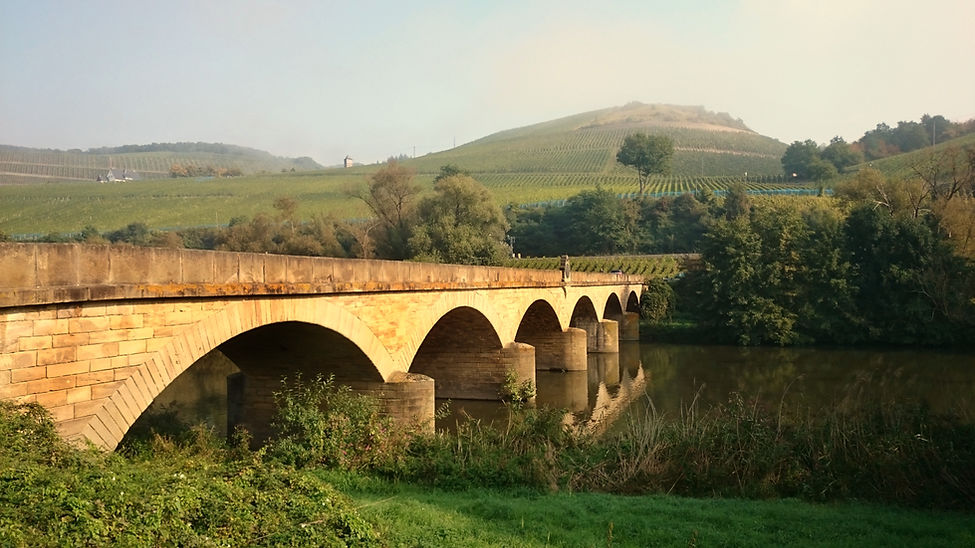TRAVEL IMPRESSIONS OF AN ART AND HISTORY LOVER
and my experiences as a teacher in China
UMGEBUNGSENTDECKER
Rhine, Moselle, Nahe



at the moment there are only photos here
Der Rhein
The Myth
The wine regions in the west are well suited for a short trip or a long weekend.
So I decided to go there with a British friend for a few days, not only because the destination is well suited for a short trip, but also because the Rhine is something like the epitome of Germany for the British. They discovered it in the 19th century after the continental barrier was lifted in 1813 and it became a popular travel destination. The effect of this area on the Brits can be traced in the travels and paintings of William Turner or in the novel "Vanitiy Fair" by William Makepeace Thackeray, which was set in Königswinter in the 1830s and was followed by 82 international literary critics in 2015 was voted one of the greatest British novels.
It is also worth mentioning the fate of Idilia Dubb, an art student from Edinburgh, who died while exploring the ruins of Lahneck Castle because a rotten staircase had collapsed and made it impossible for her to return, so that she died of thirst because she couldn't make noticeable. When people wanted to rebuild the castle later during the Middle Ages cult, their remains and a diary were found in which they recorded her last days.
Mary Shelley was inspired to write the novel "Frankenstein" during her trip on the Rhine in 1814 when she saw the ruined castle Frankenstein and heard that an alchemist was supposed to have experimented with human bodies there. However, this incident about Mary Shelley belongs more to the realm of laying the ground.
But the Rhine was a myth not only for the Brits. In 1802 the German poets Clemens Brentano and Achim von Arnim traveled along the Rhine on post ships and founded the Rhine-myth by publishing German sagas and ballads in their collection of folk songs "Des Knaben Wunderhorn". At no stage of his cavalier tour did the Prussian Arnim feel as deeply moved as on the Rhine.
Medieval castles that were blown up by French soldiers in the wars of reunion or later by French revolutionary troops were continuously rebuilt, including the aforementioned Lahneck Castle, where Idilia Dubb died, but also Stolzenfels Castle near Koblenz, Sooneck Castle near Niederheimbach, Burg Rheinstein bei Trechtingshausen etc. Also the completion of the Cologne Cathedral should be mentioned in this context or the rebuilding of the Speyer Cathedral in 1822, which was destroyed by Napoleonic troops and almost completely demolished by them.
The 19th century was the century of longing for the Middle Ages and romanticism, and the Rhine offered a lot of material to satisfy this longing.


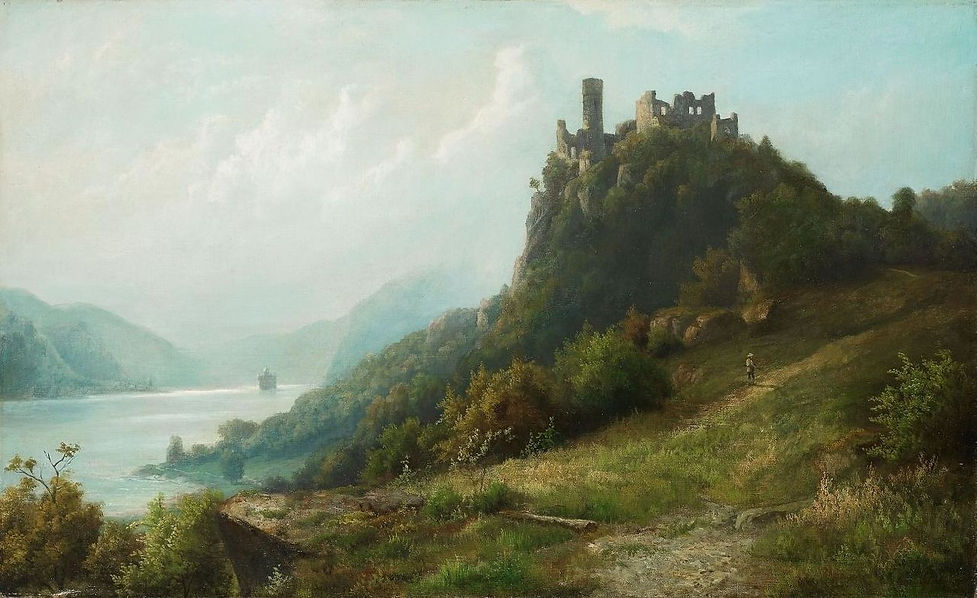
The Rhine Valley
World cultural heritage, but also urban sprawl and landscape destruction
The Rhine myth of the 19th century is long gone and today the Rhine Valley looks very different from when it was the favorite travel destination of the British in Germany.
Before you can embark on the picturesque Rhine, you first drive from the north via Cologne, through rather battered areas.
The areas around Bonn, Bad Godesberg and Koenigswinter are sprawled and, in my opinion, destroyed or, as they say today - used up. Petrol stations, car dealers, advertising signs, parking spaces, new buildings, developed expressways, highways, industrial areas - the full range ... and there is no end to the agony for the eye. You see something like that everywhere, you just want to get away from it.
One wonders how beautiful it could be or how beautiful it once was. In between you will see a villa in Schinkel's classicism or a castle with a tower from the 19th century in the neo-Gothic style.
Remnants that are reminiscent of the times when you still had your weekend home on the Rhine with a view of the Drachenfels, the island of Nonnenwerth or the Rolandsbogen.
These relics seem lost today.
Is there anyone else who would buy and maintain such properties? Is it worth spending millions in an aesthetically unattractive environment?
Probably financially strong people are considering choosing a different area to invest in luxury real estate. This development does not only destroy the area, but in the long term the devalued cultural heritage will also disappear. One only needs to remember the closed Grand Hotel Loreley or the Burghof, both in Königswinter.
From Unkel, i.e. when you have left North Rhine-Westphalia, it becomes more picturesque with places like Linz am Rhein or Remagen.
From Koblenz up the Rhine the Rhine valley becomes narrower and from there begins the section that is classified as a world cultural heritage as far as Bingen.
However, urban sprawl is also a problem in the Rhine Valley in the section between Koblenz and Bingen: Many localities, in which the houses crowded around the church in earlier centuries, have now become street villages because the buildings of the 1960s, 1970s, and 1980s Years along the quayside to the place-name sign.
A bridge is planned in the beautiful Rheingau to connect Rheinhessen. In the not too distant future, working people will commute daily from Rhineland-Palatinate to Wiesbaden, sprawling the area with new development areas and increasing the volume of traffic.
Nevertheless, you can spend wonderful days on the Rhine and you can still find the myth, even if not in the form from back then.
The section between Koblenz and Bingen
Stolzenfels Castle
Auf der linksrheinischen Seite, südlich von Koblenz und gegenüber der Lahnmündung, thront Schloss Stolzenfels – ein märchenhaftes, gotisch anmutendes Bauwerk, das den Zauber der Rheinromantik in seinen Mauern bewahrt.



1842 wurde Stolzenfels nach Plänen des Architekten Karl Friedrich Schinkel auf Geheiß des preußischen Königs Wilhelm IV. auf Ruinen der Vorgängerburg errichtet. Die vorherige Burg war vom Kurtrierer Erzbischof Arnold von Isenburg in den Jahren 1242-1249 errichtet worden. Sie diente der Sicherung der Territorialgrenze von Kurtrier gegen Kurmainz, das auf der gegenüberliegenden Rheinufer lag. 1688 wurde die Burg von den Franzosen im Pfälzischen Erbfolgekrieg niedergebrannt und diente seitdem als Steinbruch.
Nach dem Wiener Kongres fiel die gesamte Rheinprovinz an Preußen. Im dann beginnenden 19. Jahrhhundert war die Rückbesinnung auf das Mittelalter genauso angesagt wie romantische Verklärung, woraufhin die Pläne für den Wiederaufbau entstanden.
(Willst du wissen, warum die Rheinprovinz zu Preußen kam? Klick hier.)
Stolzenfels Castle is located on the left bank of the Rhine, south of Koblenz and opposite the mouth of the Lahn. In 1842 it was built on the ruins of the previous castle according to plans by the architect Karl Friedrich Schinkel at the behest of the Prussian King Wilhelm IV. The previous castle was built by Archbishop Arnold von Isenburg from Electoral Trier in the years 1242-1249. It served to secure the territorial border of Electoral Trier; Kurmainz lay on the opposite bank of the Rhine. In 1688 it was burned down by the French in the Palatinate War of Succession and has since served as a quarry.
The entire Rhine province fell to Prussia after the Congress of Vienna. Medieval history was just as popular in the 19th century as romantic transfiguration, which is where the plans for the romanticizing building came from.
Do you want to know more about the Congress of Vienna and why the Rhine province came to Prussia? click here.
Today's castle was designed in the neo-Gothic style and is a successful example of Prussian Rhine Romanticism. A visit should not be missed. The interior is a mixture of medieval art, weapons, furniture and paintings combined with 19th century neo-gothic fittings. The wall paintings in the castle chapel and in the small knight's hall are among the most important works of Rhenish High Romanticism. The other famous Prussian who created around King Friedrich Wilhelm IV was the garden architect Peter Joseph Lenné, who designed the gardens. The garden with fountain and pergola exudes a romantic harmony.The only thing that bothers you is the view of the sprawling Rhine Valley. The whole castle looks like a fairytale castle and that's how Friedrich Wilhelm IV and his wife Elisabeth Ludovika of Bavaria wanted it.
Do you want more know about the buildings of Friedrich Wilhelm IV? click here.
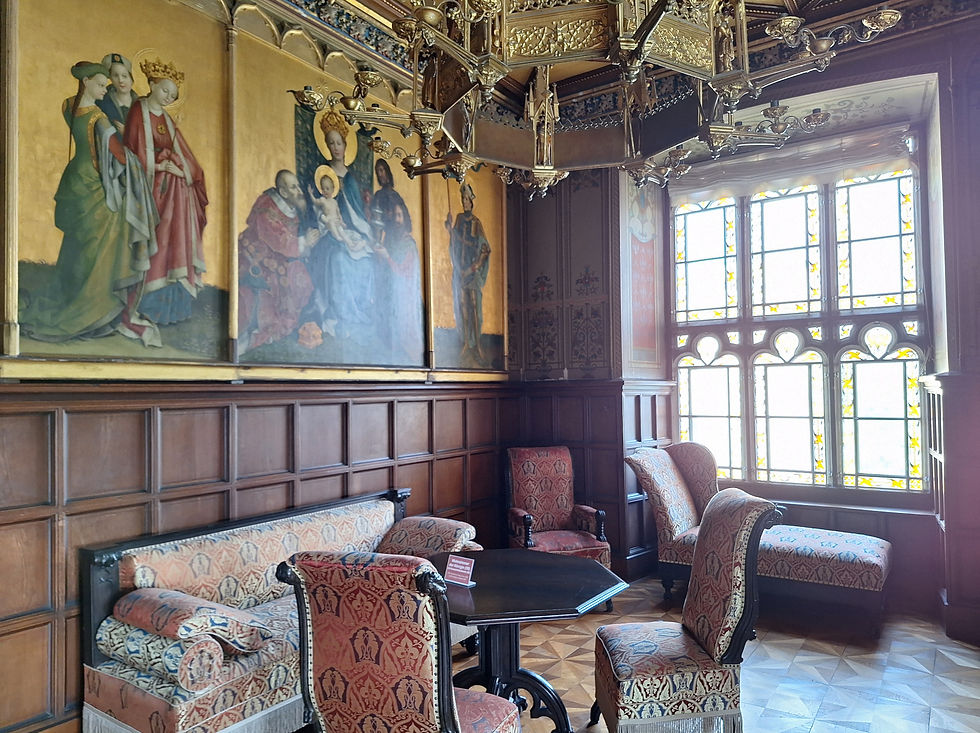

Die Wandmalereien in der Schlosskapelle und im Kleinen Rittersaal gehören zu den bedeutendsten Werken der rheinischen Hochromantik.


Der andere berühmte Preuße, der im Umfeld von König Friedrich Wilhelm IV. schuf, war der Gartenarchitekt Peter Joseph Lenné, der die Gartenanlagen entwarf.
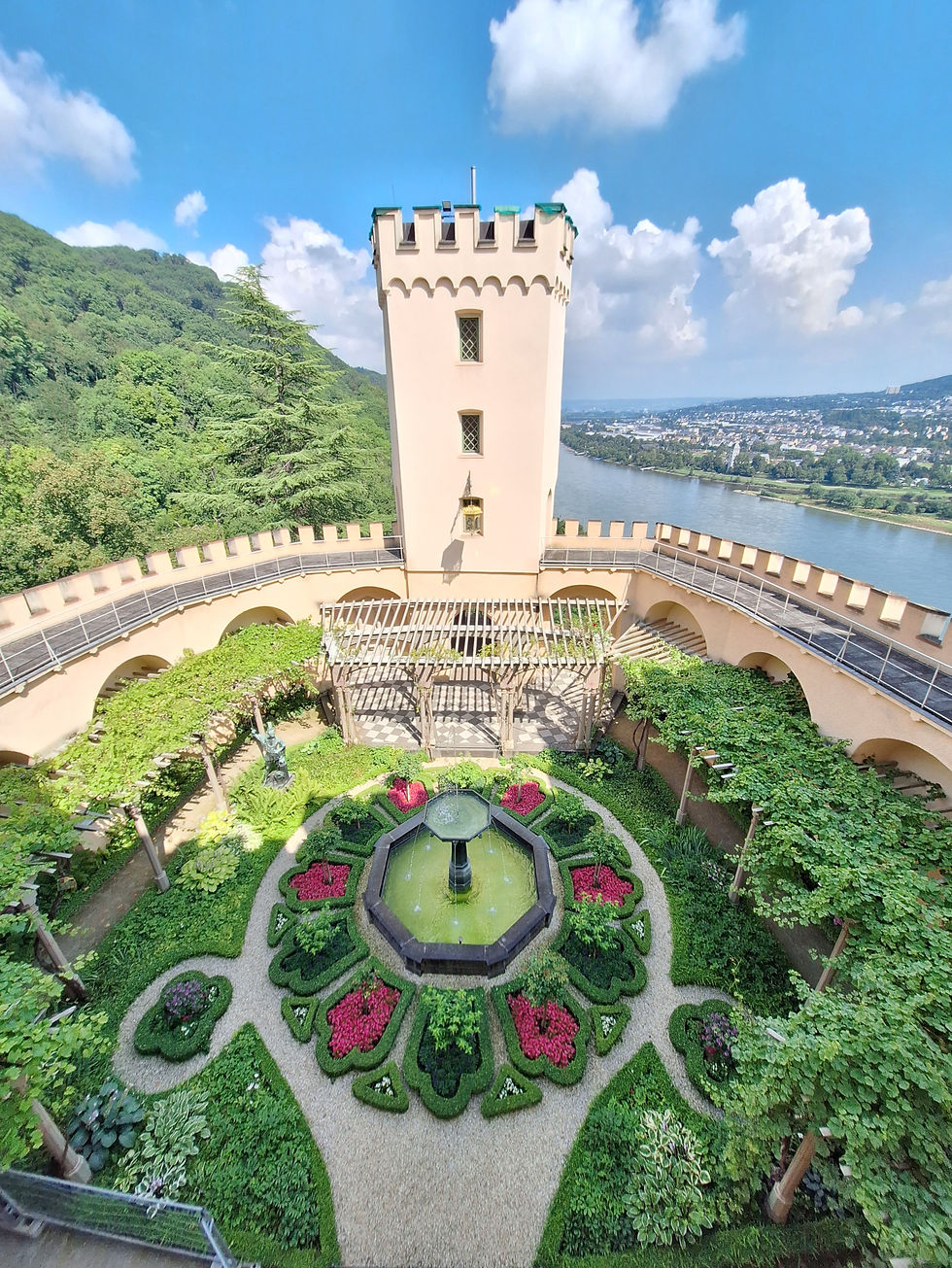
Der Garten mit seinem Springbrunnen und der von Wein berankten Pergola verströmt romantische Harmonie. Die gesamte Burg erscheint wie ein Märchenschloss – ganz so, wie es König Friedrich Wilhelm IV. und seine Gemahlin Elisabeth Ludovika von Bayern beabsichtigten. Elisabeths bayerische Wurzeln sind unverkennbar: Weiß-blaue Gestaltungselemente begegnen dem Besucher in nahezu jedem Winkel des Schlosses.
(Willst du mehr über die Bauten wissen, die in Preußen unter der Regentschaft von Friedrich Wilhelm IV. gebaut wurden? Klick hier.)
The area around Bacharach
Bacharach has a preserved town wall with towers and gates and the town with its half-timbered buildings has been completely preserved. Even Victor Hugo and Brentano were fascinated by the beauty of the place. Victor Hugo wrote in his diary: "Bacharach is probably the oldest place inhabited by humans that I have seen in my life. It is believed that a giant who dealt in antiques wanted to set up a general store on the Rhine. This old fairy town where it teeming with sagas and legends, is inhabited by a quaint strain of residents." Today you approach the picturesque town via the Rheinuferstraße and we were already impressed by the city wall with its gates and towers. The Alte Posthof (Old Post Office) of Thurn and Taxis has been in town since 1593 (The Thurn-und-Taxis Post was a private postal service and the successor to the Imperial Reichspost of the Holy Roman Empire).
Every desired Rhine cliché is fulfilled there: a cobblestone inner courtyard, the Gothic ruins of the Werner Chapel above on a ledge, the half-timbered ambience in the courtyard, in the inn beautifully framed etchings and paintings with views of the Rhine on the walls. A wooden spiral staircase swings up at an open corner of the building in the courtyard, and if you walk through the restaurant to the Winand Tower, you can see paintings from the 15th century inside. The Thurn and Taxis' postal administration only moved here in 1724. In the 19th century, the European aristocracy is said to have come en masse to the Posthof. In the village we continue to the Altkölnischer Hof. It is centrally located next to St. Peter's Church. The Kurkölnische Saalhof, which was owned by the Archbishopric of Cologne, once stood there. This hall was a multi-purpose building in which court camps (King Ludwig of Bavaria, 1314), weddings (Emperors Charles IV and Anna of the Palatinate, 1349), city council meetings (from 1356), wine exchanges and court hearings (in the 15th and 16th centuries ) took place. In 1810 the hall was demolished by the French. The building that has been reconstructed today is the Altkölnische Saal, and the hotel in it is the Altkölnische Hof.


Hotel Altkoellnischer Hof
A few meters further you will find the old house. It is one of the best-known half-timbered houses on the Rhine and perhaps also in all of Germany and is depicted in many illustrated books and calendars. It was built in 1586, but its beginnings date back to the 14th century. The Old House has survived all the city fires and destruction caused by wars. Inside you can see murals from the 19th century, including the Loreley cycle.

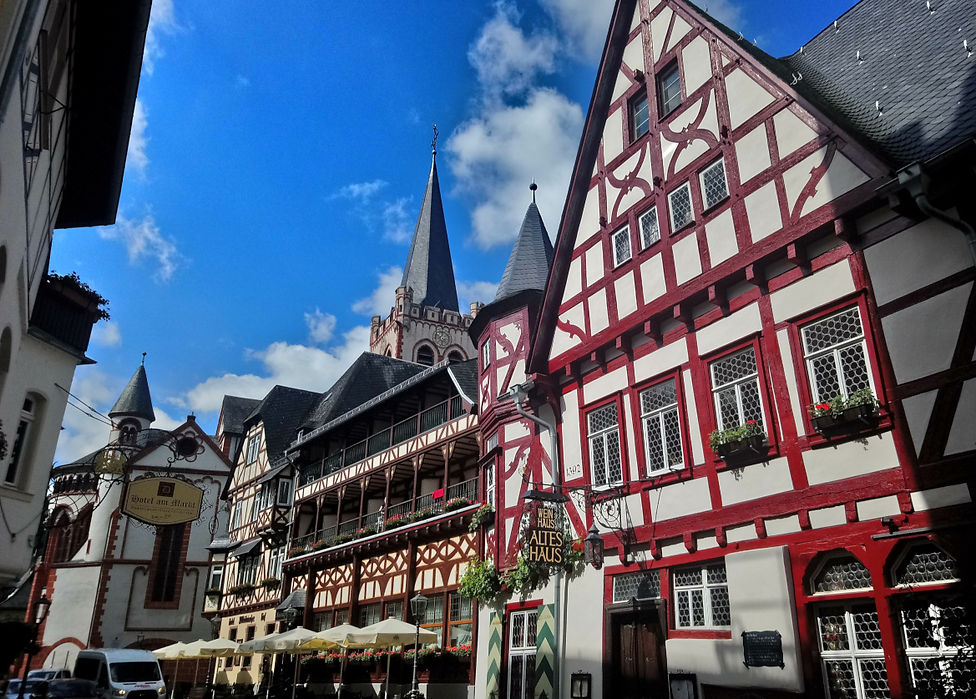
The old house and to the left of it the Hotel Altkölnischer Hof
If you go further, after a few meters you will reach the Alte Münze. This is where guilders and hellers of the Rhenish Coin Association were minted. It all started with the Rhenish Elector Palatine Ruprecht I, who had the first coins minted here in 1356. On the street side you can see a plaque with the names of the electors whose mint masters worked here in the years 1356-1508.
In all three houses, Kurkölnischer Hof, Altes Haus and Alte Münze, you can eat well and because of the beautiful ambience it is definitely worth it.
To get to Stahleck Castle, follow Blücherstraße, which runs west between the Altkölnische Hof and St. Peter's Church to Malerwinkel (painter's corner), from where the Burgweg winds its way up in serpentines.
Stahleck Castle is now a youth hostel. You can't visit it from the inside and therefore it doesn't offer much, except that you have a good view of the Rhine from there.
Actually, it is an important building for the history of the Palatinate. It was built in 1135 by the archbishop's bailiffs of Kurköln. The reign of Cologne in the Bacharach area ended when the Staufer king Konrad III lent the Pfalzgrafschaft (Palatinate) to his brother-in-law Hermann von Stahleck in 1142. The castle became the residence of the Count Palatine on the Rhine and thus temporarily the center of the Count Palatine.
In 1156 the Hohenstaufen Emperor Friedrich I, known as Barbarossa, a nephew of Hermann von Stahleck, made his half-brother Konrad von Staufen Count Palatine. So that he could perform his duties better, he him the Salian-Staufian estate on the Rhine with territories of Donnersberg, Nahegau, on the Haardt and the Bergstrasse, in the Kraichgau and goods and rights that were shared with the Staufen bailiwick via the Worms church and the monastery Lorsch. These goods formed the nucleus of the later Palatinate territory. As a result, the focus of the County Palatine gradually shifted from Bacharach to Heidelberg.
In 1194 the legendary marriage of Konrad's daughter Agnes to Heinrich, the son of Heinrich the Lion, took place at the castle, a liaison between the Staufers and the Guelphs, with which the Staufer-Guelph dispute was to be settled.
During the Thirty Years' War the castle was besieged and conquered a total of eight times. In the Palatinate War of Succession, started by Louis XIV, it was blown up by French troops, and large parts of the Electoral Palatinate were devastated by the French. When the castle was blown up, the Werner Chapel below was destroyed at the same time. Reconstruction was not carried out because of the severity of the destruction and was not started until 1925.
The Werner chapel under the castle was 1289-1430 built as a high Gothic central building. The reason for the construction was the murder of a boy named Werner in 1287, whose murder was blamed on the Jews of Oberwesel without evidence, which led to a pogrom on the Middle Rhine, as a result of which 40 people were killed. As a result, this chapel was built, which became a popular place of pilgrimage. It was destroyed when the castle was blown up, parts of which flew up to the chapel. In the Romantic period, these ruins were considered particularly noble.
You can also start a city wall circular route from Stahleck Castle, which takes you through all the towers and city gates of the city and climbs to the surrounding vineyards,

Summer night on the Rhine
Christian Eduard Böttcher , 1862, oil on canvas, 117 × 183 cm,
License: public domain
Castle Pfalzgrafenstein near Kaub

Pfalzgrafenstein Castle is located very close to Bacharach on an island in the Rhine. For the sake of simplicity, it is called the 'Palatinate near Kaub'.
If you want to get to the island with the castle, you have to cross by boat from the Kauber side. There is some beach on the island, a few tall trees that stand in the Rhine when the water is high and of course the Veste. The barges pass by so close you can touch them - it looks impressive.
It was built in the first half of the 14th century and, together with other castles (Burg Stahleck, Burg Gutenfels, Burg Herzogenstein and Sauerburg), belonged to the Palatine Barrier Ring, which was intended to secure the northern border of the Palatinate against the expansionist desires of the Counts of Katzenelnbogen, whose territory lay south of River Lahn and extended close to border of the Palatinate. However, the Palatinate was not a closed territory. This part including Bacharach and Kaub was small and surrounded by Electoral Mainz and the county of Katzenelnbogen. Pfalzgrafenstein Castle was not only used for security, but also as a customs post.

There are all sorts of things to see inside the building, including an interesting animated film that illustrates the times of navigation on the Rhine in the Middle Ages, giving you an idea of how trade took place on the river and the function of the Palatinate, namely the monitoring of the customs revenue of the paying office in Kaub. The old customs office can still be seen from the outside in Kaub.
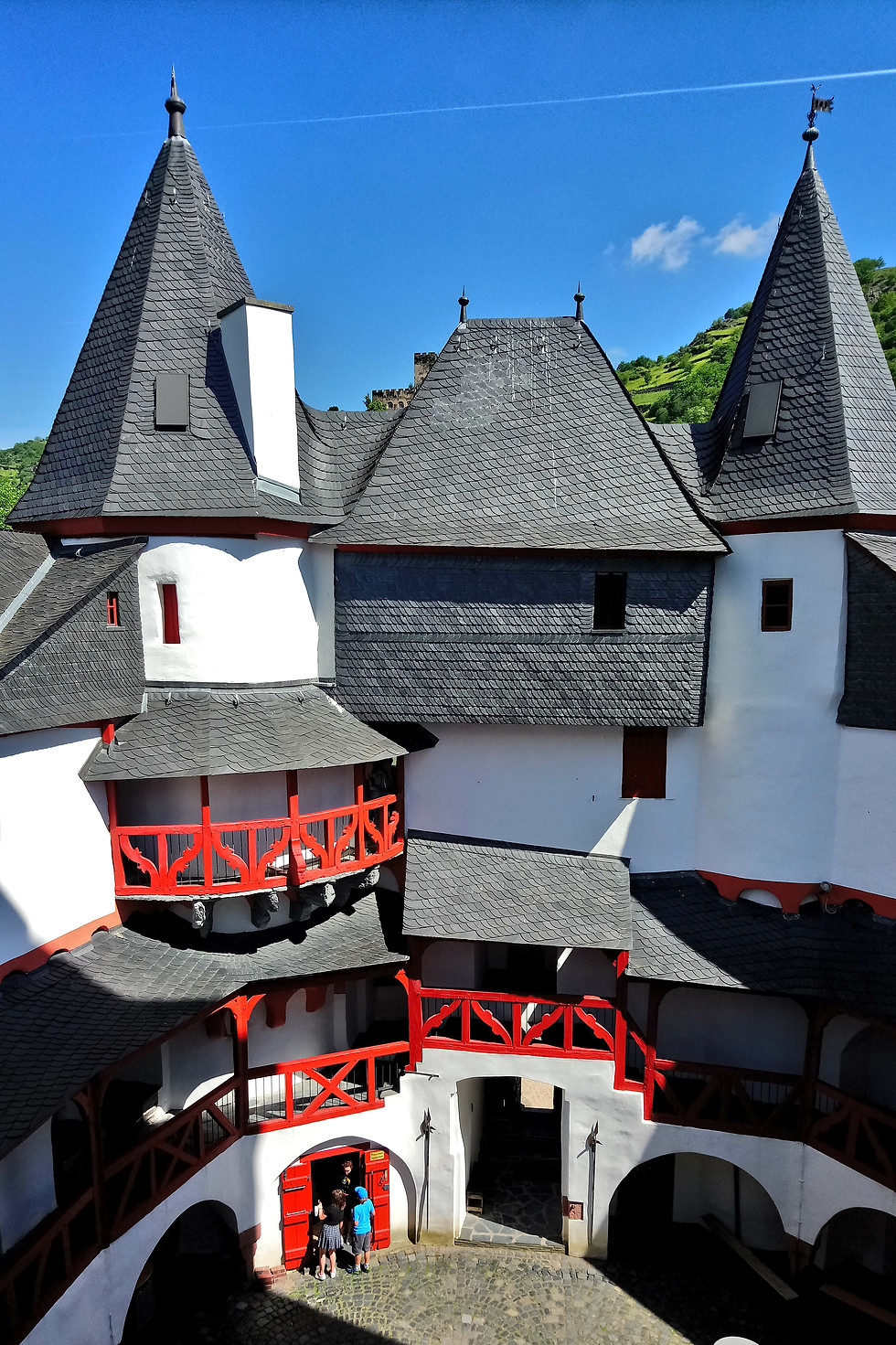
A historical event of gigantic proportions occurred in the 19th century when the Prussian General Blücher was on his way to Waterloo with an army of 50,000 men and 15,000 horses to defeat Napoleon in alliance with the British.

Here at the Palatinate near Kaub, the entire army crossed the Rhine on New Year's Day 1814 using a pontoon bridge. The Blücher Museum in Kaub in the former Hotel Stadt Mannheim, where Blücher stayed during the operation and which had been a hostel since the 17th century, commemorates the event. Blücher's original rooms have been preserved and a museum explains the entire period from the French Revolution through the Wars of Liberation to Waterloo.

Heinrich Heine and the Rhine
The German poet Heinrich Heine wrote the unfinished novel 'The Rabbi of Bacharach' in 1825, a story of evil denunciation in which a child's corpse was foisted on the Bacharach Rabbi Abraham and his family by strangers. They took advantage of the rabbi's hospitality after being invited into the house because they could not find a place to stay. Heine was probably inspired by the historical event surrounding the above-mentioned Werner from Oberwesel, who gave his name to the Werner chapel in Bacharach, and who died in the 13th century under unclear circumstances. His death was blamed on the Jews, thereby establishing a bloody persecution of the Jews on the Middle Rhine. I personally found the part of the fragment of the novel interesting, in which the rabbi, who had to flee from the denunciation, arrives in Frankfurt's Jewish quarter. One can imagine and mentally reconstruct life in the district through Heine's novel. The Jewish Quarter on Judengasse existed until the end of the Napoleonic Wars, when the requirement that all Jews had to live there was lifted. (Would you like to know more about the Judengasse? More details can be found on the Frankfurt page. Click here.) Heine and the Rhine are inextricably linked, above all through the song about the Loreley.
Here is a link to a version of the Loreley on a disk music box, as invented in Leipzig at the end of the 19th century. I'm always amazed by the voluminous, rich sound when these old music boxes start playing.
The Loreley rock in the Rhine is ultimately less spectacular than the myth that surrounds it. There are more lovely corners on the Rhine and on countless paintings the Loreley looks more dramatic than it ultimately is. It is enough to keep this myth in mind when you are on the Rhine. In the end, I didn't find a trip to the foot of the rock worthwhile, especially since Goarshausen was rather disappointed as a place.
Eltville

The Rheingau
The Rhine Valley is narrow between Koblenz and Bingen. From the Binger Loch, the gorge-like course is over. Upstream, in the direction of Mainz and Wiesbaden, the Rhine becomes wide and the character of the landscape is generous. On the right bank of the Rhine lies Hesse with the Rheingau, on the left bank of the Rhine lies Rhineland-Palatinate with Rheinhessen. Rüdesheim, the tourist magnet with the Drosselgasse, is located on Binger Loch. Many avoid the place because it is too touristy, but the hustle and bustle is part of it and Rüdesheim is really too beautiful to skip it.
Rudesheim
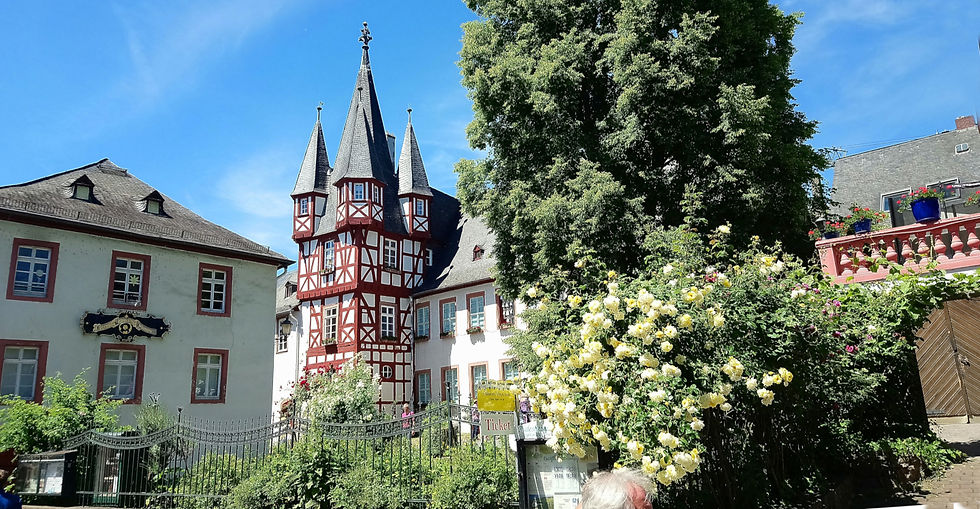
Asbach Uralt is distilled here, so the brandy belongs in the Rüdesheim coffee, which you can get, for example, in Café Engel in the Drosselgasse: Not cheap, but really good. There is also a small show at the table, in which Rüdesheim coffee is prepared and explained in front of the astonished visitors. The brisk waiter did all this in English for my British visit and garnished his explanations with questions about English football - meanwhile the sugar cube was soaked with Asbach, everything was flambéed, deglazed with coffee, whipped cream on it - done! This may seem like grandma's favorite drink, but some of what our ancestors drank and ate might be better than you think. For example, the Jägermeister was very successfully rehabilitated a few decades ago. (Addendum, as of June 2022. Café Engel no longer exists, Corona has probably put an end to it, but Rüdesheimer Café is also available in many other places.)





A recommended tour can be taken from Rüdesheim with the so-called "Ringticket", a combination ticket that takes you from Rüdesheim to the Niederwald monument by cable car. From there, a signposted hiking trail starts through the Niederwald on the heights to the Niederwald hunting lodge, from there you can take a chairlift down to Assmannshausen, where you can take a boat from the Bingen-Rüdesheimer-Schiffahrtgesellschaft back to Rüdesheim. It is also worth taking a look at the castle on the opposite bank, Rheinstein Castle near Trechtingshausen. You should plan a total of five hours for this day trip.
More information about the ring ticket? click here .
The Niederwald Monument
Even if you don't want to do the circular route, it's worth taking the cable car to the Niederwald Monument. You leave the lively Rüdesheim with the gondola and as soon as you have left the valley station you are immediately surrounded by restful peace. You float silently over the vineyards. Relaxing, this silence for about ten minutes. Above all, there is a pleasantly cooling breeze in the open gondola - a welcome refreshment, especially on hot midsummer days in the Rheingau. From the gondola you can see a few very brave people who want to make the ascent on foot through the burning hot vineyard slopes and struggle uphill under the sun at the zenith.

The Niederwald monument is a relic of bad times in the relationship between Germany and France. Germania watches and looks west to protect the Rhine from enemies coming from the west. Ever since Louis XIV, the south-west of Germany had been a scorched piece of land that had always been ravaged and burned by the French, as one could already read from the constant destruction of castles etc. mentioned above. The consequences of this arch-enmity are well known. Fortunately, one can no longer imagine such nationalistically charged feelings nowadays and it is to be hoped that this will remain the case.

Hildegard von Bingen

Sculpture of Hildegard von Bingen in the cath. Parish Church St. Hildegard , Ruedesheim am Rhein
Saint Hildegard von Bingen (1098 - 1179) is one of the most important women of the Middle Ages. If you walk in their footsteps, you are in the right place. The stations of her life are Disibodenberg an der Nahe, Bingen and Rüdesheim. The Benedictine monastery where she spent most of her life and childhood was in Disibodenberg in the Nahe region. She was admitted there in 1112 at the age of 14. Today only a ruin can be found on the site of the monastery. There is said to be a force field there - some say the strongest in Europe - where many visitors can still feel the spiritual aura of the place. Even as a child, Hildegard had visions in the monastery. Pope Eugene III recognized her visionary abilities and thanks to papal confirmation she became one of the most famous women of her time. There was a quarrel with the abbot of the Disibodenberg monastery, so that Hildegard, at the age of 53, after having lived in Disibodenberg for 40 years, founded her first monastery in 1151 on the Rupertsberg near Bingen, in what is now the district of Bingerbrück. Nothing remains of the monastery in Bingen except for the cellar, which lies exactly under the abbey church of the former monastery. Since Hildegard came from a noble family, dealing with powerful personalities was not difficult for her and thanks to these skills she was able to obtain a protective privilege from the emperor for her monastery. Why did Hildegard go to Bingen? The settlement was at the mouth of the Nahe in the Rhine - a junction. In addition, the Rhine was already an important traffic artery with important former Roman cities that became bishoprics in the Holy Roman Empire. Roads in the country were added. So you were in a part of Germany with a highly developed infrastructure. The density of important buildings on the left bank of the Rhine, i.e. the former Roman side, is also evidence of this: the cathedral of Aachen, the imperial cathedrals of Speyer, Worms and Mainz, important bishoprics such as Mainz, Trier and Cologne. This area was a center of secular Christian power in the medieval empire. In the Middle Ages, Christianity in Germania progressed continuously from west to east, so the highest level of development was on the left bank of the Rhine. More eastern areas were only added after 800 or after 1000 and lagged behind the development by a few centuries.
When Hildegard's monastery on the Rupertsberg was bursting at the seams, she founded a second monastery on the opposite side in 1165 Rhine side in Eibigen, today's district of Rüdesheim. Around 1900, the Benedictine nuns moved from there to the newly built Abbey of St. Hildegard above Rüdesheim in the vineyards, where they honor Hildegard's legacy and produce wines there as the only religious winery in Germany where nuns actively participate in the production of wine. The sisters of the convent are open to the present day, to the amazement of many visitors they are in the midst of life and offer a wide range of activities for those who are interested, e.g. hikes through the vineyards or public events where they answer questions from visitor groups, journalists and associations. Gregorian chants are sung five times a day in St. Hildegard Monastery. You can hear the singing in the church if you come at the right time as a pilgrim or tourist, some visitors find their way here precisely because of this, others come by chance and assume that the chorale with its flawless, bell-free sound comes from the tape, because you does not see the sisters singing, they are sitting in a nave north of the altar. The spiritual aura is beautiful. It is the only monastery in Europe where Gregorian chant is still sung daily.

Benedictine Abbey of St. Hildegard in the vineyards above Rüdesheim. The sisters produce their own monastery wine.


Bronze sculpture of Hildegard von Bingen by Karl Heinz Oswald in the forecourt of the Hildegard monastery

The interior of the Abbey Church,
Romanesque architecture with Art Nouveau paintings

Why did Hildegard become so famous? She was a doctor, herbalist, abbess, mystic, composer. In 2012 she was promoted to Doctor of the Church, becoming the fourth woman in Church history.
As a botanist, she collected and interpreted the knowledge of the time about the herbal medicine of her time, which contains statements on all en aspects : treatment of usual illnesses, driving away demons, plants that stimulate or alleviate love life, etc. But she was also interested in the use of herbs to treat illnesses . "Cause et Cure" was her book about the diseases and their cures, "Physica" was her writing about their medicinal formulations.
In the Middle Ages it was believed that four humors - blood, phlegm, yellow and black bile - must be in balance in the body of a healthy person. As soon as they get out of balance, man becomes ill. These four bodily humors were assigned the properties moist, dry, cold and warm. For example, to restore balance, a person suffering from an illness brought on by cold, damp phlegm was treated with a dry, warm plant.
Her view of the connection between the world, people and nature seeks balance, because health lies in the balance, as soon as something turns to extremes, it gets sick. As soon as things get out of whack, the primal forces scream .
She recorded her visions in her book "Scivias". It was her best-known book in the Middle Ages and is now considered her most important. The only illuminated manuscript that was produced in Hildegard's time is in the Hildegard monastery in the vineyards near Rüdesheim.
Hildegard's legacy for today is that we must treat creation with care, because man is a co-worker with God in shaping and maintaining the creation. At the time, this was a revolutionary thought: God had created the world, but man is called to collaborate in its further development and care.
These thoughts are currently and with Hildegard's writings you can reach people again today after 900 years.
If you want to find out more about Hildegard, a visit to the Bingen Museum am Strom, located directly on the Rhine, is worthwhile. There is a large permanent exhibition about Hilgard
Then it is worth taking a trip up the Rochusberg to the Rochus chapel, another important anchor point on a pilgrimage on the trail of Hildegard. There is a rib of hers there as a relic.
The pilgrimage church of St. Hildegard with the reliquary in which her bones are kept is located in Rüdesheim Eibigen.

Reliquary of St. Hildegard from 1929, made of gilded copper, made by the goldsmith Josef Kleefisch from Maria Laach according to a design by the Benedictine Radbod Commandeur from -bb3b-136bad5cf58d_ Cologne was manufactured, St. Hildegard (Eibingen) , Rüdesheim am Rhein
Johannisberg Castle,
Fürst von Metternich, the best Riesling and the Trockenbeerenauslese

Where Johannisberg Castle is located today, there was a Benedictine monastery early on, which was ruined in the Peasants' War of 1524/25 and the Markgräfler War of 1552. In 1563 it was dissolved with the death of the last abbot, and finally the mountain was mortgaged. Things only got better in 1716 when the prince abbey of Fulda bought the Johannisberg and had a summer residence built there for the Fulda prince-abbot, the Johannisberg Castle, where Riesling has been cultivated in the vineyards ever since. The domain describes itself today as the first Riesling winery in the world. Here bottling was introduced and the dry berry selection was discovered. This discovery happened rather accidentally. Every autumn, grapes were brought from the Johannisberg to the prince-abbot in Fulda so that he could decide on the harvest. In 1775, however, the courier was delayed, so the return to the Johannisberg took much longer than the usual eight days. In the meantime the grapes on the Johannisberg had gone rotten. Nevertheless, wine was made from it and it was noticed how tasty it was, so that one learned to appreciate the noble rot and developed the late harvest into a system. Beerenauslese and Trockenbeerenauslese as well as Ice Wine, i.e. wine made from frozen grapes, were also discovered here in 1858.

The castle suffered during the Napoleonic Wars that took place between France and other European powers. After the Reichsdeputationshauptschluss in 1803, the Johannisberg was passed back and forth. From the House of Orange-Nassau to the French Empire, to the Archduchy of Austria, until it was then presented by the Austrian Emperor Franz I to the Austrian Foreign Minister Duke Metternich for services at the Congress of Vienna. At that time, sparkling wines became fashionable and Metternich teamed up with Jacob Söhnlein and made the Fürstensekt (Duke's sparkling wine) from excellent Riesling wines, which won the gold medal at the 1867 World Exhibition in Paris. The Metternich family has been using their name to guarantee the quality of the sparkling wine since 1925, and Prince von Metternich's portrait has been on the bottle since 1971. The castle was destroyed in World War II and rebuilt after the war with the help of the food manufacturer Dr. Oetker. Oetker and the Metternich descendant were good friends, so that after Metternich and his wife died childless, the castle passed to Oetker. To this day, the Oetker family has an apartment in the castle. Also the Rheingau Music Festival takes place there. You cannot visit the castle from the inside. But you don't miss anything - there is no longer a baroque interior.



The Brentanohaus in Oestrich-Winkel
A few meters further from the castle there is the so-called Goetheblick, today a wine tasting stand in the vineyards with a beautiful view of the Rhine Valley.
Goethe was in the Rheingau several times. Worth mentioning is his visit in the late summer of 1815 to the Brentanos, the well-known Frankfurt merchant family, whose children Clemens and Bettine enriched romantic poetry in Germany. The family owned a summer house in Oestrich-Winkel. This house can still be visited today. It was sold by the Brentanos to the State of Hesse in 2014, which turned it into a museum. The house has several rooms that have never been modified since the Romantic period, so you can take a real journey through time. In addition, the house was a center of Rhine Romanticism at that time, where not only Goethe found himself, but also Achim von Arnim, the Brothers Grimm, Freiherr von Stein and Karoline von Günderode. The gentle landscape of the Rheingau and the rocky Middle Rhine Valley with its castles stimulated the imagination of many writers, so that the Rhine Romanticism arose here and the Brentanohaus became a focal point and meeting place.
Since nothing has been changed and today you can see how the Brentanos and their guests lived then, the house is a cultural and historical monument of the first rank. "The historically outstanding building conveys - also through architecture and landscape - a topographical reminder of the Romantic era, which had a lasting cultural and historical impact on the Rhine/Main landscape," agrees the Brentanohaus Friends Group.
More information about guided tours? click here .
Castle Vollrads

From Johannisberg Castle you can hike to Vollrads Castle. It is practically next door in the vineyards, about two kilometers away and belongs to the municipality of Winkel.
It consists of the core of a medieval castle built by the Greiffenclau family. The residential tower of the castle is now in the middle of a pond and can only be reached via a small bridge. Later Baroque buildings were built around the courtyard.
Castle Vollrads is a wonderful place to taste wine and enjoy traditional, simple dishes from a tavern. You sit under old trees, chestnuts, lindens and robinias and look at the harmoniously arranged buildings and the pond.

A tarte flambée, pretzel, asparagus salad, hand cheese with music (Hands mit Musik) and Spundekäse with the Riesling. Handkäs mit Musik is Harzer cheese pickled in vinegar, sprinkled with finely chopped onions and caraway. Delicious. Spundekäs is cream cheese with creamy quark, salt, pepper and red paprika powder and chopped or sliced onions sprinkled on top.
Ever since members of the Greiffenclau family first sold wine to the St. Viktorstift in Mainz in 1211, the cultivation of Riesling in the vineyards of Schloss Vollrads has continued to develop. 800 years later the anniversary could be celebrated as one of the oldest wineries in Germany.




Eltville
If you continue from Rüdesheim to Eltville, in Hattenheim, a wine tasting stand in a park between the Rheinuferstraße and the river invites you to linger. At the self-service stand wine is sold in neat glasses, the atmosphere is reminiscent of ostrich or broomsticks. Find a bench or table, ideally with a view of the river, and enjoy your Riesling with a view of the ships passing by and the sparkling water in the sunlight. The river now looks almost like a lake. Islands, called floodplains here, make the river appear even wider. White motorboats lie in quiet harbors, the towns look prosperous, the houses are spruced up. In addition to beautifully renovated medieval half-timbered houses, you can see pastel-colored baroque facades and some villas. The contrast between the open wide in the Rheingau and the fjord-like valley downstream, into which the Rhine disappears from the Binger Loch, is big. Here in the area around Eltville you can feel the vastness and light, while in the narrow valley it is more of a gloomy atmosphere. In front of Hattenheim and Erbach, lies the island of Mariannenaue, which is several kilometers long. Together with the island, the stream here has a width of up to 560 meters. The island is a nature reserve and no one is allowed on it except farm workers, residents or guided groups of visitors. Despite nature conservation, Riesling is grown there, which is why there is a pretty manor house on it. The island belongs to Schloss Reinhartshausen in Eltville/Erbach, which has been producing Riesling wines since 1337. It received its name Mariannenaue from the Dutch Princess Marianne von Oranien-Nassau, who acquired the Reinhartshausen Palace in 1855. Incidentally, Marianne was the daughter of Wilhelmine of Prussia and Wilhelm of the Netherlands and also granddaughter of Frederick William II, who in turn was the nephew of Frederick the Great.
Prinzessin Marianne von Oranien-Nassau
Ihren Namen Mariannenaue erhielt die Insel von der niederländischen Prinzessin Marianne von Oranien-Nassau, die 1855 das Schloss Reinhartshausen erwarb. Marianne war übrigens die Tochter von Wilhelmine von Preußen und Wilhelm von den Niederlanden und außerdem Enkelin von Friedrich Wilhelm II., welcher wiederum Neffe von Friedrich dem Großen war.

Marianne of Orange-Nassau, Image source here
She was quite an unconventional woman, having separated from her unfaithful husband Albrecht of Prussia. From then on she was ostracized in Prussia and the Netherlands and lived with her middle-class partner, with whom she had a son Johannes, at Reinhartshausen Castle, which she expanded into a cultural center on the Rhine. She owned a collection of over 600 works of art, for which she had the palace expanded with a gallery building that no longer exists. A small part of the collection can still be seen in the castle, which until recently was a hotel. Unfortunately Corona has ruined the hotel operators. Now Ukrainian refugees are housed there. Marianne's son Johann died of scarlet fever as a teenager at the age of 12, after which she gave the Erbachers a neo-Gothic, evangelical church, the Johanneskirche .

The neo-Gothic St. John's Church in Eltville Erbach
It would be worth researching what happened to her collection and which illustrious personalities gathered at her castle at a time when the Rhine was on top of the list of travel destinations for aristocrats and bourgeois travellers. In 1932 there was an auction of 171 art objects from the Reinhartshausen Collection, Rheingau in Berlin. That must have been her art collection. The catalog of the works to be auctioned at the time can be viewed digitally in the Heidelberg University Library (click here.) In general, Marianne was a fairly successful entrepreneur who managed and increased her possessions in such a way that her descendants became the richest branch of the Hohenzollern dynasty. Not only did she own the Rheingau Castle, she also had the somewhat oversized Kamenz Castle built by Schinkel in Silesia, bought the Villa Calimontana in Rome, owned the Villa Carlotta in Tremezzo on Lake Como, which she gave to her daughter when she got married, she financed the Wilhelmsturm in Dillenburg with the largest share, Erbach donated the evangelical church etc. (Want to know more about the Wilhelmsturm in Dillenburg? Click here.) The journey continues to the center of Eltville. Signs point the way to wineries, the number of Michelin restaurants is increasing, and there are sparkling wine cellars at the entrance to the town. Eltville is a gem with a beautiful old town and an electoral castle, which is located directly on the Rhine. Next to the castle is the rose garden and the Eltville Rose Days are particularly noteworthy. Then it foams from rose blossoms, entire city walls are covered with climbing roses, there are culinary delights at stands, wine on the banks of the Rhine in the sun - days like this are not forgotten.
Eltviller Rosentage
Eltville ist ein Kleinod mit einer schönen Altstadt und einer kurfürstlichen Burg, die direkt am Rhein liegt. Besonders hervorzuheben sind die Eltviller Rosentage. Dann schäumt es von Blüten, ganze Stadtmauern sind meterhoch mit Kletterrosen bewachsen, der Rosengarten an der kurfürstlichen Residenz zeigt, was er kann, und bei dem dazugehörigen Stadtfest gibt es an den Ständen an der Promenade viel Kulinarisches und Wein unter schattenspendenden Platanen - solche Tage vergisst man nicht.








Herrenhaus auf der Königsklinger Aue

Mansion on the Königsklinger Aue
Mansion on the Königsklinger Aue
During the Eltville Rose Days, the castle, Eltville's landmark, forms a perfect backdrop, especially since the so-called official garden on the residence territory is a rose garden. From the defensive wall you have a wonderful view of another Rhine island, the Königsklinger Aue opposite, with a Point de Vue, a baroque building with a high mansard roof on the island, a flight of stairs that leads directly from a sculpted veranda with columns and balustrade to the water . The property cannot be visited, it is privately owned.
Kurfürstliche Burg Eltville

Electoral Castle Eltville
In 1328 there was a double election for the bishopric in Kurmainz, one of the three ecclesiastical electorates (Kurmainz, Kurköln and Electoral Trier). The Mainz cathedral chapter elected the Archbishop of Trier, Balduin of Luxembourg, as Archbishop of Mainz, and at the same time the Pope installed another archbishop, Heinrich von Virneburg.
This double occupation made Eltville the second bishop's residence next to Mainz. The construction of a castle began in 1330, which became the preferred residence of the archbishops of Mainz in the 14th and 15th centuries. During the Thirty Years' War, the Swedes destroyed the castle.
Today the residential tower, which remained intact, houses a museum shop, a count's chamber with murals from the 14th century and a mighty fireplace, a Gutenberg exhibition and much more.



Tower of the Electoral Castle in Eltville
Eberbach Monastery
Above Eltville is Eberbach Abbey, the location of the film 'The Name of the Rose' and a beautiful state winery with interesting wine cellars. The former dormitory of the monastery, seen below, was the scriptorium in the film where the monks wrote and painted codices. One can attend a wine tasting at the monastery, which takes place in the wine cellar, lit by candles standing on the wine barrels in dim but atmospheric lighting.
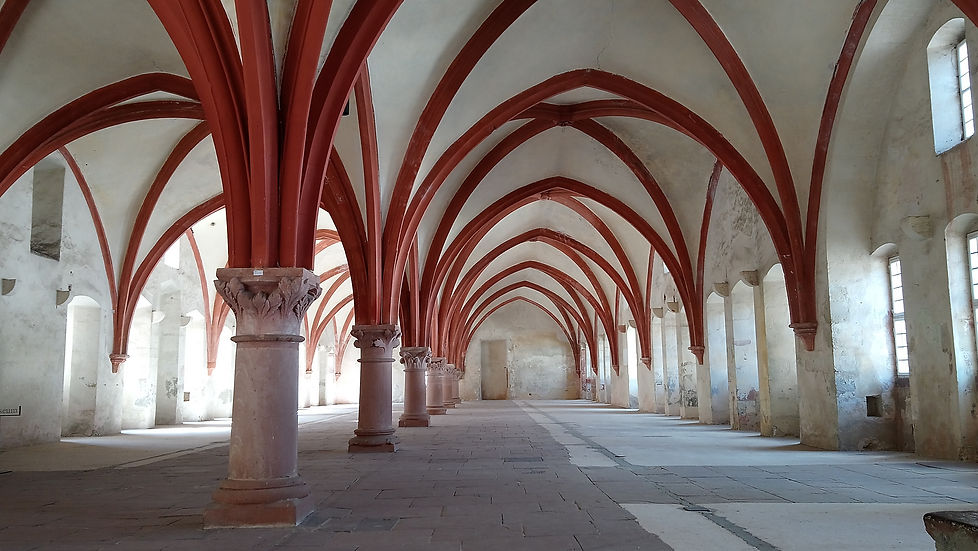
The dormitory in Eberbach Abbey, location for the film In the Name of the Rose

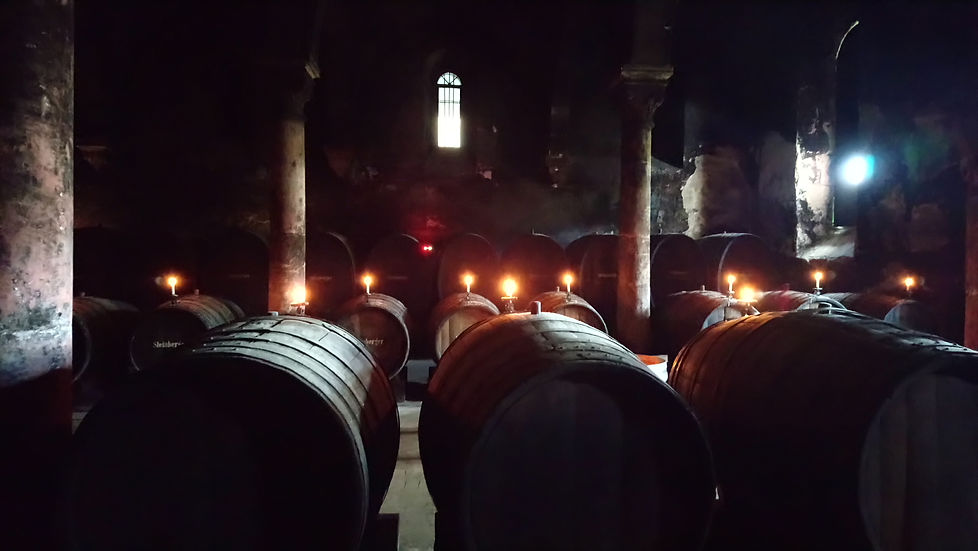

Hochheim
A little further away from Eltville, remote and not particularly interesting for tourists, but still quite exciting - I had visitors from England - was a visit to Hochheim am Main, because there is a monument there that commemorates Queen Victoria's visit to the Rhine. In 1845 she was on a trip to the Rhine with her German husband Prince Albert (She was German as well, both from the House of Saxony-Coburg and Gotha). As lovers of Hocheim wines, they took the opportunity to visit the vineyard owned by winemaker Georg Michael Papstmann, whose slope was considered the best. In 1850, Papstmann asked Her Majesty if he could name the vineyard after her, the Queen. In the same year, the Queen gave permission to do so. Three years later, the mountain was renamed by the Nassau authorities, and Papstmann erected the Queen Victoria Monument, which was dedicated on May 24, 1854, the Queen's 35th birthday - a beautiful monument in English Gothic Revival style.


Queen Victoria with her crown, a small version specially made for her because the large crown was too heavy for her. Want to know more about Victoria? On the page about Franconia, learn more, clickhere.
Incidentally, the Hochheim-Rheingau Riesling is still sold today by the London wine house Berry Bros. and Co. (The British call it Ho"ck"heim because they can't pronounce the "ch" in "Hoch" and abbreviate it to "ck"). If you look closely at the historical price list, you will see that the Reingau Rieslings were priced higher than the great Bordeaux wines. Berry Bros. has been around since King George III. Purveyor to the court of the English royal family to this day. The company was founded in 1698. In the 19th century, the Rheingau was firmly in the hands of aristocrats, in Wiesbaden emperors, tsars and kings cured - and of course everyone drank Riesling.


Today the area around the monument is no longer particularly appealing. A regional train on an oversized concrete track drives right past it, in the distance you can see the Opel factories in Rüsselsheim, power poles spoil the area, several high-rise buildings protrude in the background. The monument itself was scaffolded when we visited it and had been waiting for a renovation for a long time (that's why I posted an internet photo as we could only see the scaffolded monument). In the meantime, however, it has been newly renovated and spruced up. But not many people go there. We were seeking for the place, there was no sign pointing it out and it felt like we were the only ones who seem to get lost there except for a few strollers who take their dogs out.

Moselle
While the Rhine resembles a straightened shipping highway, the Moselle meanders through its original valley between the Hunsrück and Eifel. It has a low current and often looks like a lake, so that you can hardly tell the direction of flow. This is due to the many locks that calm them down. It is also significantly less busy than the Rhine, only occasionally a leisurely barge passes by at a low speed. It is not squeezed into a brick river bed, but its banks drop down naturally from the road to the water. When driving on the shore road, it often seems as if you are driving almost at river level. There is little traffic on its banks, a railway line runs from Koblenz to Bulley and then disappears into the Voreifel. It is tranquil. Going on holiday on the Moselle is real deceleration with wonderful silence.
Koblenz

Deutsches Eck
Our journey along the Moselle begins at the Deutsches Eck in Koblenz, where it flows into the Rhine. Koblenz is a big city with over 100,000 inhabitants. Compared to the places that await you on the Moselle, things are quite lively here. The Deutsches Eck is an artificially raised promontory on which a monumental equestrian statue of Kaiser Wilhelm I stands today. From there, promenades with parks and restaurants lead along the banks of the Rhine and Moselle. Incidentally, the name Deutsches Eck comes from the Teutonic Order, a religious order that is remembered above all because they made crusades to the Holy Land and Christianized and colonized the north-east of Central Europe to the Baltic States, the best known is probably the Marienburg near Danzig, one of the Main sights of Poland and former seat of the Teutonic Order in the east. This order had a branch at the Deutsches Eck, right where the Rhine and Moselle met. Today only the Deutschherrenhaus, the ruins of a chapel and the gatehouse remain from the extensive building complex caused by war damage the Deutschordende Koblenz remained. The equestrian statue on the headland is a reconstruction as the original one from 1897 was destroyed in World War II. In the decades after the war, the base remained empty and became a memorial to German unity. Until 1993 there was a flagpole with the German flag. Today's reconstructed statue goes back to the initiative of a Koblenz publisher. In 1993, after much controversy, the replica of the monument was placed there.
The Rhine Province and its predecessors
At the confluence of the Rhine and Moselle you find yourself on former Roman territory. The Roman foundations of Mogontiacum (Mainz), Augusta Treverorum (Trier) and Colonia Claudia Ara Agrippinensium (Cologne), which later became important bishoprics and electoral seats in the Holy Roman Empire, are within a 100-130 km radius. Koblenz itself was also founded in Rome and is therefore one of the oldest cities in Germany. Its Latin name is Confluentes, meaning the confluence of two rivers. The area came more into focus after the Thirty Years' War, when for centuries the Rhine was the subject of contention as to whether it was Germany's border as the French saw it, or Germany's river as the Germans wanted it. As a result of this ongoing conflict, the areas on the left bank of the Rhine, the Palatinate and the Saarland, were often attacked by the French in the Palatinate Wars of Succession, one reason why many castles on the Rhine are now only ruins. From 1798 to 1814, Napoleonic troops occupied the area up to the Rhine and called it the Rhine-Moselle department. Later, after the Congress of Vienna in 1815, this area was added to the Kingdom of Prussia and Koblenz became part of the Prussian Rhine Province, which was founded in 1822. The destroyed castles were partially rebuilt in the 19th century, people longed for the Middle Ages and the Holy Roman Empire of the German Nation and pursued the idea of a German empire. The Rhine Province was the westernmost of all Prussian provinces and stretched from the Saarland to the Lower Rhine. With this province, Prussia became the protective power of Germany on the western border. Koblenz was the seat of the Upper President of the Rhine Province. However, the Rhinelanders were not very convinced Prussians, they were open to the ideas of the French Revolution, which can be seen in the Rhenish law, which was valid on the left bank of the Rhine, i.e. in Koblenz, Trier and Cologne, and corresponded to the Napoleonic Code Civil. In the Evangelical Church, the Prussian provinces still exist today in the form of member churches, so today's "Evangelical Church in the Rhineland" corresponds to the former Prussian Rhine Province.
The old electoral palace Philippsburg
Opposite the Deutsches Eck on the other side of the Rhine is the Ehrenbreitstein Fortress, to which a cable car leads from the Rhine promenade. This means of transport was built for the 2011 Federal Horticultural Show and will have to be removed again as soon as it is in need of an overhaul. Otherwise, the status of the Middle Rhine Valley as a World Heritage Site should be revoked. While the fortress up on the mountain with its unadorned bastions seems inaccessible and military, there is a beautiful baroque building at the foot of the mountain, directly on the Rhine, the castle-like administrative building, which was built according to plans by Balthasar Neumann and Johannes Seiz, in which the administration was housed by Electoral Trier. The administration had been brought to Koblenz after the Electors of Trier had moved from the threatened Trier to Koblenz during the Thirty Years' War. There, under the direction of Elector Philipp Christoph von Sternes, they had the Philippsburg Palace built in the early Baroque style between 1626 and 1632. In the middle of the 17th century, the administration followed suit. The old Philippsburg Castle no longer exists. It was north of the former administration building, directly below the fortress on the banks of the Rhine. During the First Coalition War (1792-1797) it was destroyed by the French, who occupied the Ehrenbreitstein Fortress but had to abandon the right bank of the Rhine in 1801, following the Treaty of Lunèville. Before they left, they blew up the fortress, which also destroyed the castle below. By this time, however, the Electors of Trier had already moved into a new palace. In 1786, Elector Clemens Wenzeslaus von Sachsen had started the new building on the left side of the Rhine, i.e. the old town side. He needed a more representative palace because he was used to other representation options in Saxony and Poland than in Trier and Koblenz. From Deutsches Eck you walk along the Rhine promenade for about 1.5 kilometers and get directly to the castle. Today it is a post-war reconstruction in the form of the 1950s, reflecting the eventful history of the last 250 years. The interior that Clemens Wenzelslaus took with him when he had to flee from Napoleon's troops is now in Aschaffenburg Palace, Nymphenburg Palace and the Residence in Munich, the City Residence in Landshut and the New Residence in Bamberg.
Ehrenbreitstein Fortress
At the time of its destruction, Ehrenbreitstein Fortress did not look as well-fortified as it does today; it was a baroque building. After Electoral Trier went to Prussia as part of the Rhine province, Prussia built today's fortress between 1817 and 1828 to protect the Middle Rhine Valley. The building was considered impregnable and is one of the most important fortifications in Europe. If you want to visit the fortress, however, the current visitor concept is difficult to understand. The first obvious question when you see Ehrenbreitstein is: Why is there such a massive fortress on this spur? The answer is missing. As soon as you arrive by cable car, you realize that the way to the entrance is poorly signposted. In the fortress, too, you are pretty much left alone when looking for information. Connections are not explained, but you learn a lot about the catering of the soldiers and the toilets, e.g. that the little place was bomb-proof. Perhaps the artwork next to the latrines, made of toilet brushes arranged in the letter B, refers to bomb safety. The catering information section is headed with the announcement "No Munch No Fight". Original, but not very revealing for the question of the political conditions that gave rise to this fortress. There are also reconstructed detention cells and guard offices. We remained quite at a loss and were rather alienated by the toilet brushes. The region you are in, the Middle Rhine (this also applies to the Upper Rhine), was a politically highly charged focal point between France and the Holy Roman Empire and later Prussia from Louis XIV until the Congress of Vienna. It is perhaps not an exaggeration to rate the weight of this charged situation at the time as very high. For a very long period of time, the conflict between Germany and France determined the development of politics in western central Europe. So it would be interesting to learn more about it. You don't learn much more than latrines, munch and dungeons and a few cannons, but at least you could visit the fortress.


Castle Eltz


Instagram has made Eltz Castle even more popular than it was before. Thousands of photos are popping up on the internet. It's worth getting there early if you want to avoid crowds. The castle is one of the most beautiful in Germany, by the way, it adorned the 500-mark note from 1961-1993. It was never destroyed and has been owned by the Counts of Eltz for 34 generations. It takes about 15 minutes from a parking lot through a forest that suddenly opens up into a valley. There it appears in front of you - the legendary castle. It looks like a tower, beautiful, crooked, with many extensions and oriels, especially the roof region is picturesque with its half-timbering and the many different turrets and roof shapes. The castle was actually expanded and enlarged over the centuries, but it still looks like it was made of one piece. The area on which it stands is not particularly large. There was a lack of space because it is on a rocky outcrop rising out of the valley. You couldn't build in width, so it went up. Why did it have to keep growing, in this case upwards? The castle is a so-called Ganerbenburg, i.e. to avoid inheritance disputes among three brothers, the castle was divided equally among the three brothers in 1268, who then increased their respective areas to get more space. In total, the castle consists of three residential units. It's a bit reminiscent of Hogwarts with its four houses in a castle. The history of the Eltz family began 850 years ago when Emperor Barbarossa gave the knight Rudolf von Eltz a residential castle on the trade route between Maifeld and the Moselle. Nowadays only the Eltz-Kempenich line is the owner of the castle. The rest had sold their shares to their brothers. The host Dr. Karl Graf von und zu Eltz-Kempenich, known as Graf Eltz, lives with his family in Frankfurt. Its castle welcomes a quarter of a million visitors every year. The old walls are in good shape, a thorough renovation in the years 2009 to 2011 for more than four million euros let them shine again. By the way, the castle was never destroyed. A miracle in this part of Germany. How did that happen? A relative, Anton zu Eltz-Üttingen, was serving in the French army at the crucial time and crossed the castle off the list of buildings to be destroyed.
Ostrich farms, broom farms and Co.

When you are traveling along the Moselle, it is one of the cozy moments to stop off at an ostrich inn. You can recognize them by the wreaths that hang in front of the gates of the winegrowers' houses. Sometimes there are also brooms with colorful ribbons or other signs that announce the possibility to stop for refreshments. Depending on the region, they are also called Besenwirtschaft, Besenschänke etc. You usually sit in the courtyard of a winery, sometimes in a barn on simple benches or right in the wine cellar. If the inn is in the inner courtyard, it is often covered with vines and it looks a bit like a small beer garden. In these inns there is wine from their own cultivation and small dishes such as sausage plates, tarte flambée, Spundekäs etc. A tavern is a so-called "permission-free business", i.e. you can operate it without a permit, but it may only be open four months a year, may not offer any accommodation and the menu may only offer cold or simple warm dishes.

Saumagen is one of the classic dishes of an ostrich restaurant in the Palatinate - sometimes it sneaks onto the menu on the Moselle. Ultimately, the stomach is a shell that is filled with a mixture of sausage meat, pork belly and potatoes, heavily seasoned with marjoram. So basically like a sausage, only the filling doesn't go into an intestine, but into a stomach. The whole thing is sewn up and cooked. After cooling, the pig's stomach is sliced, then fried. Top!
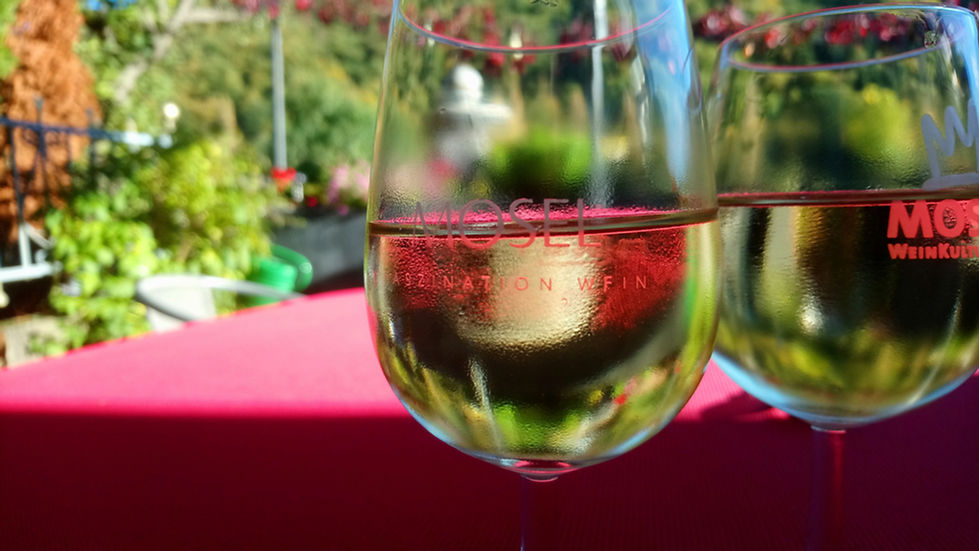

Cochem

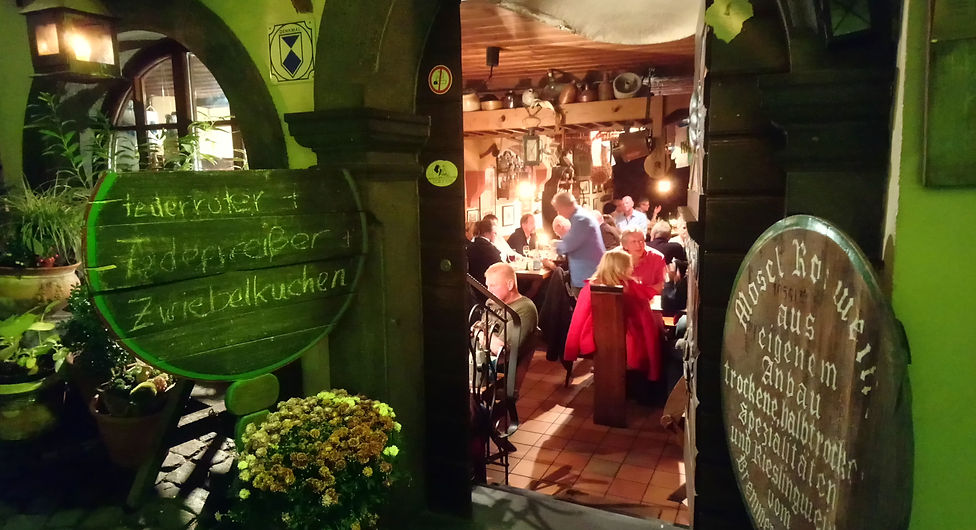




Beilstein
Beilstein is a high point on the Moselle, but the small town is easily overlooked as most visitors to the Moselle focus on Cochem, Traben-Trarbach and Bernkastel-Kues. The small town is less crowded with tourists, although it comes with a completely closed townscape, lovingly restored, well-kept and without any design mistakes.

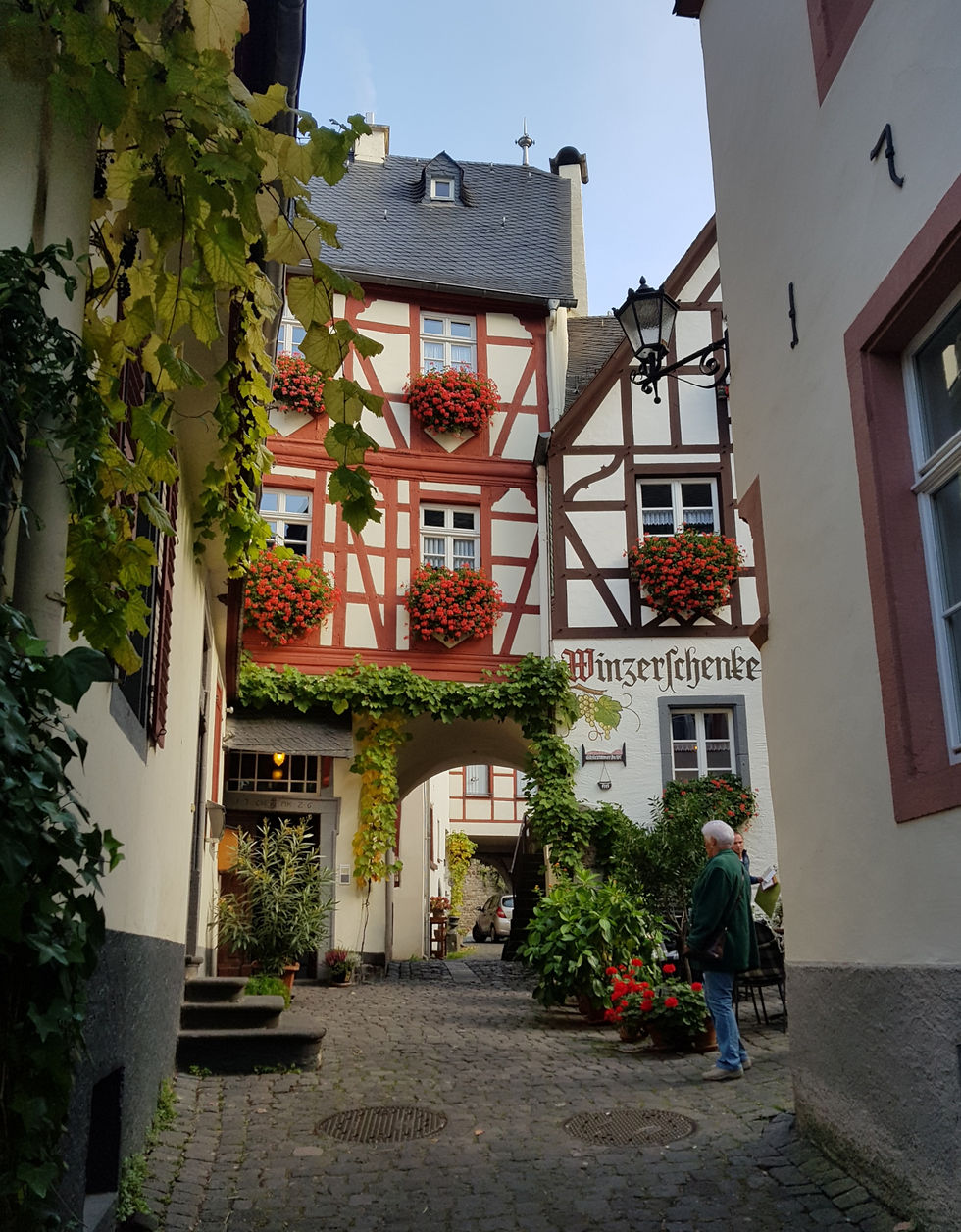


Prince of Metternich
and Beilstein
Above the town is Metternich Castle, which has been a ruin since it was destroyed in 1689 by the French in the Palatinate War of Succession under Louis XIV. The walk there is worth it because of the impressive view of the Moselle and there is a nice café. The rule of the Metternichs finally came to an end in 1794 with the occupation by French revolutionary troops. Does the name Metternich have something to do with the politician Metternich, who reorganized Europe at the Congress of Vienna, and does it have something to do with the well-known Riesling sparkling wine? Yes, with both The von Metternich family produced a number of bishops and archbishops and belonged to the high nobility. From 1652 a line of the family ruled the dominions of Winneburg (the ruins of the Winneburg are above Cochem) and Beilstein. Prince Klemens Wenzel Lothar von Metternich, i.e. the politician from the Congress of Vienna and who gave the sparkling wine its name, was the last owner of the Beilstein ruins.
He was a senior diplomat who, as Chancellor of Austria, rose to become one of the leading politicians who reorganized Europe after Napoleon's defeat at the Congress of Vienna.
The Congress of Vienna is generally regarded as a harmonious event that should guarantee peacekeeping for Europe. But the many different power interests of all European states ran counter to each other, so that one can only speak of harmony to a limited extent, a problem that has always shaped the fate of the European continent and will probably also determine its future.
With regard to the part on the left bank of the Rhine, i.e. the areas on the Moselle, the Palatinate on the left bank of the Rhine and Rhenish Hesse, there were conflicting interests between France and Prussia, which Prussia won at the Congress of Vienna. As already mentioned above, the Rhine province went to Prussia by decision of the Congress of Vienna, which thus became a protective power against France. Prussia then had an old center of gravity in the East and a new one in the West.
Der sparkling wine Prince of Metternich
The sparkling wine was given the name "Prince of Metternich" because the Austrian Emperor Franz gave his politician Metternich the Rheingau domain "Schloss Johannisberg" for his services at the Congress of Vienna. This domain had a worldwide reputation, among other things because the late harvest had been discovered there. Incidentally, the poet Heinrich Heine wrote in 1827 in his "Travel Pictures" about the Johannisberg "If only I had so much faith in me that I could move mountains - the Johannisberg would be just the mountain that I would follow everywhere.”
At that time, sparkling wines became fashionable and Metternich teamed up with Jacob Söhnlein and made the Fürstensekt from excellent Riesling wines, which won the gold medal at the 1867 World Exhibition in Paris. The Metternich family has been using their name to guarantee the quality of the sparkling wine since 1925, and Prince von Metternich's portrait has been on the bottle since 1971.
Viticulture on the Moselle
Towards the end of the 19th century there was a heyday of viticulture on the Moselle. The steep-slope Rieslings from the Mosel, Saar and Ruwer were the most coveted and expensive white wines in the world. They were drunk at the courts of monarchs from London to St. Petersburg and in top restaurants from Berlin to Paris. The best Rieslings from the Moselle were up to five times more expensive than the top wines from Burgundy.
This development was probably caused by the family
Favored relations of the English royal family to Germany. ( Do you want to find out more about these relationships? You can find out more about these relationships at Sachsen-Coburg and Gotha. Click here . ) This gave the wine from the Rhine and Moselle a better reputation and it should not be forgotten that that in that time the Grand Tours also led to the Rhine and this area became a firmly established travel destination, accompanied by wine enjoyment and much romantic notion . In Germany, wine bars also emerged in the Prussian capital . Worth mentioning are, for example, the Rheinische Winzerstuben in Leipziger Straße and Friedrichstraße or the Weinhaus Rheingold in Bellevuestraße.
At that time, Traben-Trarbach was the second largest trading center for wine after Bordeaux. The huge wine cellars under the town still bear witness to that time.
In the years after the Second World War the wine lost its reputation. Maybe that has to do with Germany's loss of reputation after the war, but certainly also with bad products and scandals (glycol wine scandal in the 80s_cc781905-5cde-3194-bb3b3b3b3b3b58d_ -136bad5cf58d_ years and sugar adulteration). In the last few decades, many winegrowers have once again strived for high quality standards and the efforts are bearing fruit. Above all, the Moselle Riesling is known and appreciated in wine connoisseur circles all over the world.
The Carmelite Monastery in Beilstein
In 1636 the Carmelite monastery was founded, also above the village, which was abolished in 1803 in the Napoleonic era. In the monastery church you can see the "Wonderful Black Madonna" brought by the Spaniards who occupied Beilstein during the Thirty Years' War. This Madonna had been housed in the Diocesan Museum in Trier since the dissolution of the monastery, but when the Carmelites returned in 1948, it was returned to its place in Beilstein, to the great sympathy of the population._cc781905-5cde-3194-bb3b- 136bad5cf58d_
Wine tasting in the Zehnthaus Cellar
In Beilstein, a wine tasting was announced for us in the Zehnthauskeller, a wine bar that is housed in the historic vaulted cellar of Metternich's tithe house built in 1574. Since 1795, when the French ended Metternich's rule, the cellar passed to the Lippmann family, who today run the wine bar.
Farmers used to pay tithes there in kind, and since wine has been cultivated on the Moselle for 2000 years, this was done in the form of wine.



Wines on the Moselle
Wine was already cultivated on the Moselle by the Celts, i.e. before the Romans. The steep slopes on the slopes of the Moselle and the other German wine-growing regions Nahe, Rhein and Ahr have zenithal sunshine, which ensures high temperatures, so that the warmth-loving wine can be cultivated there, far north of the Alps. The slate soil of the Rhenish Slate Mountains also store heat. When walking through the vineyards , you can see pieces of slate under the vines everywhere and when you touch these little black 95 stone slabs 09_cc71c1c1c5cf58d_95 -bb3b-136bad5cf58d_ you can feel the heat that they store and still radiate in the evening when the sun has already set. On early autumn nights, the river, whose water does not cool down as quickly as the air at night, creates fog over the valley, which covers the vines like a blanket and protects the wine in the late summer and autumn nights, which are getting colder.
The grape variety most cultivated on the Moselle, at over 60%, is Riesling, which grows on the steep slopes. It is followed by Müller-Thurgau, which is known as Rivaner on the Moselle. An almost forgotten medieval grape variety, the Elbling, is still grown on the Upper Moselle. The Weißburgunder, also known as Pinot Blanc, comes from Burgundy, where it was replaced by Chardonnay and made its way to Germany, where it is also grown on the Moselle.
Although white wine predominates on the Moselle, there are also red wines, the Blauer Spätburgunder and the Dornfelder.
But the star is the Riesling. Incidentally, this vine was particularly cultivated under the Trier Elector and Archbishop Clemens Wenzeslaus von Sachsen, the above-mentioned builder of the new electoral residence in Koblenz. Clemens Wenzeslaus had inferior vines cleared and replaced with Riesling, a decision that still shapes the area today. Der Riesling is actually a wine that ripens quite early, which is why its fruit can quickly become overripe and flat in warm climates. In the cool climate of the Moselle, it is considered to be late-ripening compared to those area grown for the short summer of these early-ripening 5cde-3194-bb3b-136bad5cf58d_8de - cultivars -3194-bb3b-136bad5cf58d_ T he Riesling only reaches full maturity in the best locations where the sun shines directly or reflected at the best angle. It stays am Weinstock well into autumn, allowing it to reveal the most subtle characteristics of all kinds. It impresses with its variety of tastes. Every nuance is possible, from off-dry quality wines to minerally dry top-quality wines to noble-sweet Auslese and ice wines. Especially the risky climate in German wine-growing regions, which sometimes brings top vintages, but also cold and wet years, makes these white wines particularly rich in nuances and interesting compared to southern Italian or Spanish wines, which often bring less variety.
In recent years, Prosecco has become more and more popular on the Moselle. It is actually a sparkling wine of Italian origin, but it is increasingly being produced in Germany in order to avoid the sparkling wine tax that was introduced at the time in the Kaiserreich to build up the To support Marine financially when the Kaiser wanted to develop Germany into a naval power. This tax is still levied on sparkling wine and champagne and is one of the taxes that were introduced but never abolished. Prosecco is not included as it contains significantly less carbon dioxide, the proportion of which is decisive for tax collection.

When we cycled back to our accommodation along the Moselle after our wine tasting, it was cold, even though it was already May. For a moment I wondered if it wouldn't be nicer to be in Italy now and to cycle home in the warm temperatures in the evening. But then I remembered the peculiarities of our travel destination, one of which is the cold at night, which also helps the Riesling to become one of the most unique, inimitable Weinstilen of the world and I began to like and appreciate that coldness on the return trip.

Ediger
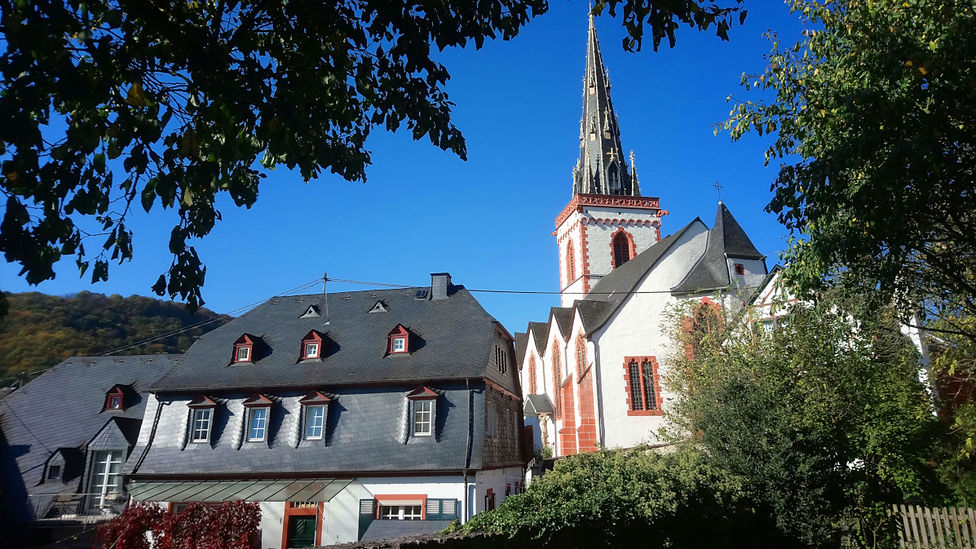
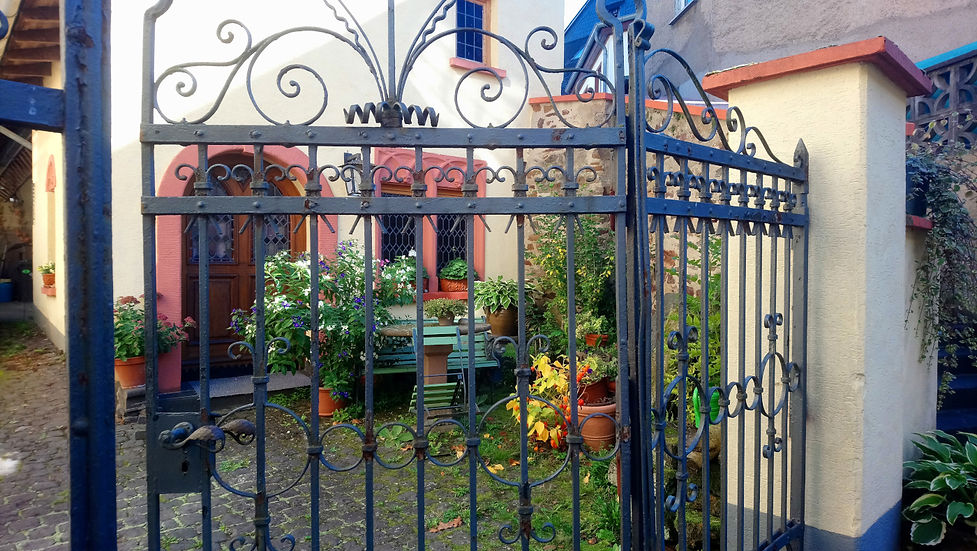
Bremmer Calmont

The "Calmont" near the wine village of Bremm is the steepest vineyard in Europe.
By the turn of the millennium, most of the parcels lay fallow. The difficult management was unprofitable, cheap mass wines and scandals were not conducive to viticulture in Germany. But since the 2000s years Riesling has been cultivated on the plots again. The Calmont sites belong to the Große Gewächse, i.e. the highest classification level for wines from winegrowers who come from the Association of German Prädikat and Quality Wineries.
You can also climb the mountain. The Calmont via ferrata has existed since 2002, a hiking trail that is more of a climbing tour and has been secured by the German Alpine Association with steel cables, step bars and ladders. The tour is not for people with dizziness or fear of heights. It begins in Bremm and ends after 3.5 kilometers in Eller. For the way you need about 1.5 hours hiking time, because you often want to enjoy the view. Perhaps you shouldn't go out in the midday heat, because the sun is beating down on the amphitheater-like steep slope at its zenith.





Zeltingen-Rachtig



Bernkastel-Kues
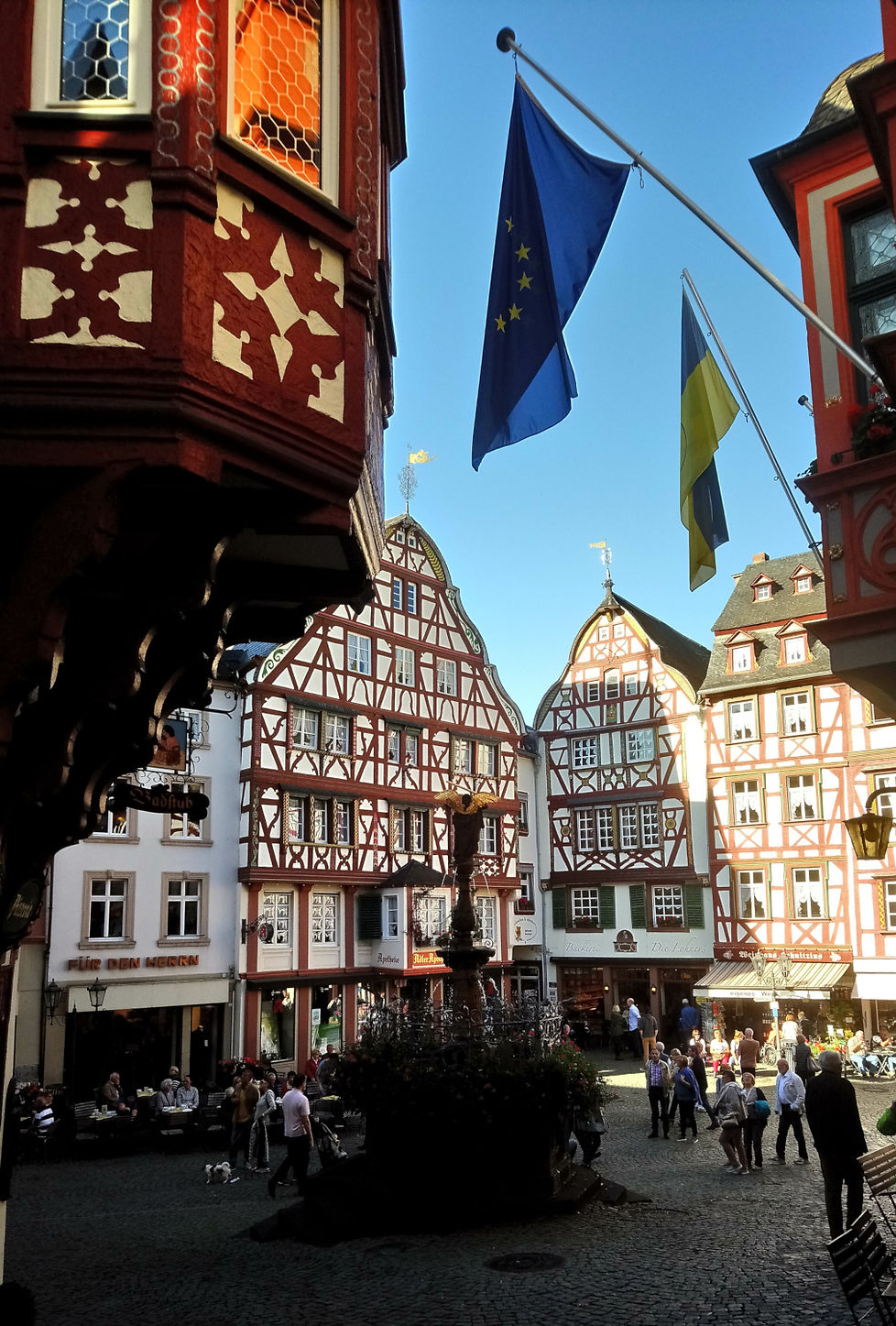




trier

Trier claims to be the oldest city in Germany. Whether this is really true depends on the definition. The fact is, however, that Trier's Roman buildings are so extensive and well preserved that one can understand the most important areas of a Roman city and with that Trier is perhaps the_cc781905-5cde- 3194-bb3b-136bad5cf58d_ Most Roman of all German cities. Everywhere you come across traces of the Romans, and they are much better preserved than, for example, in Cologne. The Roman buildings and relics are part of the UNESCO World Heritage. _cc781905-5cde -3194-bb3b-136bad5cf58d_ not just a single monument was placed under protection, as was the case initially when the UNESCO World Heritage title was awarded_cc781905-5cde-3194-bb3b- 136bad5cf58d_ common but in 1986 all Roman buildings: Porta Nigra, amphitheater, Kaiserthermen, Barbarathermen, Konstantin-Basilika, Roman bridge and Igeler pillar as well as the cathedral of St. Peter.
Trier was the residence of the Western Roman Empire from 269 to 485, Emperor Constantine resided in the city from 306-316 and took _cc781905-94-bbe-31 from here 136bad5cf58d_aus his struggle for sole rule in the Roman Empire .
In addition, the Trier Cathedral is the oldest church in Germany, and its Roman origins are also clearly visible.
But one should not forget that the city was also the residence of the Electors and Archbishops of Trier.
and last but not least, Trier is the hometown of Karl Marx.
Traces of the Roman city
A city tour starts at the best at the Porta Nigra, the only but very well-preserved Roman city gate of Trier, which was built in 170 AD. It is even the best preserved Roman city gate north of the Alps. The reason why it is so well preserved is that it was converted and converted into a church from 1035. This use protected the Roman building, otherwise it would have met the same fate as many other Roman relics, which in late antiquity and the Middle Ages were considered heretical structures and therefore worthless and were used as a quarry for building material.
Napoleon finally stopped using it as a church in 1802, gutted the original building and had it restored to its original condition. The Prussians completed this project and since then the Porta Nigra has looked like it does today.
From the city gate, follow Simeonstraße in the direction of the main market, which you can see in the picture below.

Trier Main Market
If you come from Simeonstraße, turn left into Sternstraße to the Domfreihof. An der Ecke Simeonstraße/Sternstraße steht _cc781905-5cde -3194-bb3b-136bad5cf58d_ die alte Wache, ein Barockgebäude mit drei hohen Rundbögen and a mansard roof with dormers. Today there is a retail shop on the ground floor behind the arches. The Hauptwache is part of a building complex that stretches from the market to the cathedral square on Sternstraße, the Palais Walderdorff, the former cathedral curia.
The Steipe building, the corner house with the battlements and Gothic arcade arches and the high, pointed gabled roof, is particularly striking when looking at the market. The building served as a community center and for representative purposes, later partly as a town hall. It was built in the style of medieval residential towers, some of which can still be found in Trier, such as the Dreikönigshaus on Simeonstraße . The Steipe was destroyed in the war, the current building is a reconstruction from the 1970s.
The church of St. Gangolf, which is hidden by the facades of the houses on the market, is also particularly striking, and its tower towers over it. The church can be reached from the market square through a passage with a baroque portal.
Also worth mentioning is the Petrusbrunnen with St. Peter, the patron saint of Trier, and the Löwenapotheke, Germany's oldest pharmacy, which was first mentioned in 1241 and has been family-owned since 1660.
From the market we continue to the cathedral, the oldest bishop's church in Germany. The building is architecturally and historically complex, was built over centuries and you can find building epochs from the to the Romanesque 90.cc71 5cde-3194-bb3b-136bad5cf58d_
The first cathedral complex on this site was built by Emperor Constantine in the year 310 - 320. It was about four times the size of today's cathedral. From the ancient predecessor buildings the so-called square building has been preserved, which is today a part of the cathedral. This square building covers the eastern half of the church. This part of the building can be seen from the outside where the transept rises. You can clearly see the size of the original Roman arched windows. Sie wurden im Mittelalter zugemauert und durch höhere, schlankere _cc781905-5cde -3194-bb3b-136bad5cf58d_Rundbogenfenster ersetzt. The bricked-up areas are clearly visible, the proportions of the former arched windows were much broader and they appear more stocky, although they were much larger.

Near




